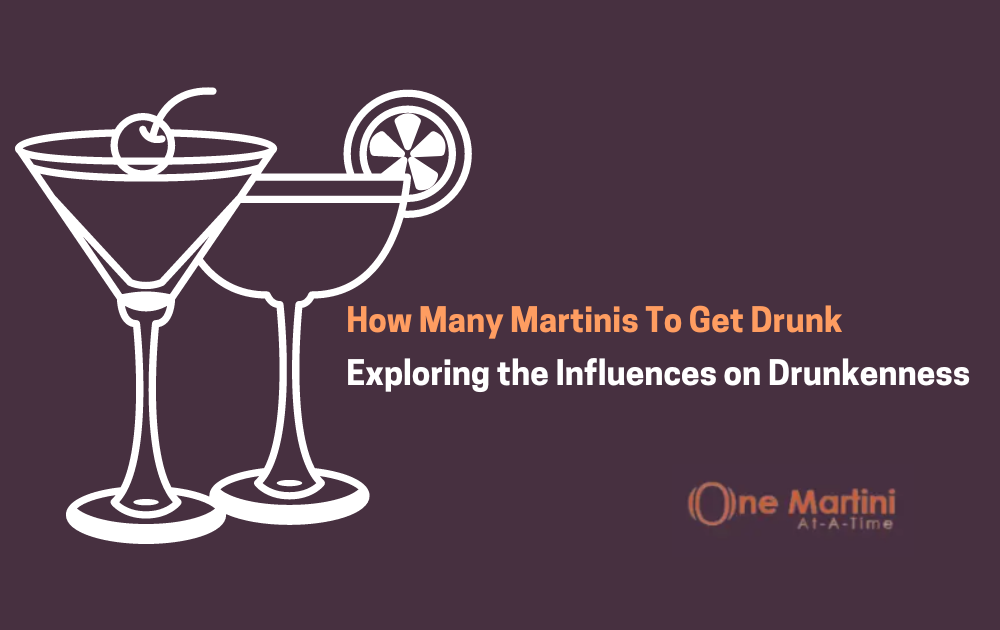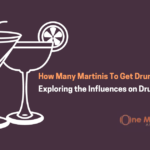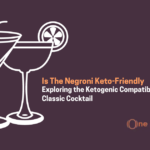The question of how many martinis it takes to get drunk is a common one, but the answer is not straightforward. The intoxicating effects of alcohol can vary greatly depending on multiple factors. While martinis are typically made with relatively high alcohol content, it is essential to consider various individual and situational factors when determining the impact of alcohol consumption.
Factors such as body weight, metabolism, gender, rate of consumption, food consumption, and personal tolerance all play a role in how many martinis it takes to reach a state of intoxication. Understanding these factors can help individuals make informed decisions about their alcohol consumption and promote responsible drinking habits.
In the following sections, we will delve into the factors that influence alcohol intoxication and discuss the considerations necessary when estimating how many martinis it may take to get drunk.
Factors Influencing Alcohol Intoxication
Alcohol intoxication is influenced by a variety of factors that can affect the way our bodies process and respond to alcohol. Understanding these factors is crucial in assessing the impact of alcohol consumption and promoting responsible drinking practices. By considering these factors, individuals can make informed decisions regarding their alcohol intake and minimize the potential risks associated with excessive drinking.
We will explore the key factors that influence alcohol intoxication. These factors include body weight and metabolism, gender differences, rate of consumption, food consumption, and personal tolerance.
It is important to note that alcohol affects each person differently, and individual responses can vary. Therefore, it is crucial to prioritize personal well-being and safety by consuming alcohol responsibly and being aware of one’s own limits.
Exploring the Influences on Drunkenness

The number of martinis it takes to get drunk can vary greatly depending on several factors. These factors include:
1. Alcohol content: The alcohol content of a martini can vary based on the recipe and the amount of alcohol used. Traditional martinis typically contain around 1.5 to 3 ounces of spirits, such as gin or vodka. However, some variations or larger-sized martinis can contain more alcohol.
2. Body weight and metabolism: Your body weight plays a role in how alcohol affects you. Generally, the more you weigh, the more alcohol it takes to reach a certain blood alcohol concentration (BAC). Metabolism also affects how quickly your body processes alcohol.
3. Gender: Women tend to have a lower tolerance for alcohol compared to men due to differences in body composition and enzyme activity.
4. Rate of consumption: Consuming martinis rapidly can result in a quicker and stronger effect compared to spacing them out over a longer period.
5. Food consumption: Drinking on an empty stomach can lead to faster alcohol absorption and intoxication. Having food in your stomach can slow down alcohol absorption, potentially delaying the onset of drunkenness.
6. Personal tolerance: Your personal tolerance for alcohol is influenced by genetics, previous alcohol exposure, and drinking habits. Regular heavy drinkers may have a higher tolerance compared to infrequent or occasional drinkers.
It is important to note that getting drunk can impair judgment, coordination, and decision-making abilities, which can lead to risky or dangerous situations. It is always recommended to drink responsibly and be aware of your own limits.
Additionally, legal regulations regarding blood alcohol concentration and driving under the influence (DUI) should be followed to ensure safety.
Alcohol Percentage In Martini
The martini is a popular drink because it’s relatively easy to make and can be enjoyed by both men and women. It has an alcoholic content of around 15-20%, which makes it one of the stronger cocktails available. Martinis are also low in carbohydrates and calories, making them a good choice for people who are watching their weight.
Martinis are a popular choice for parties and celebrations because they can be enjoyed by a large group of people. They’re also a good drink to have on hand when you want something alcoholic but don’t want to get too drunk. Be sure to enjoy your martinis in moderation, however, as too many can lead to health problems down the road!
LEARN MORE: What Alcohol Is Used In A Martini?
Alcoholic Ingredients In Martini

The alcohol content of martini varies by brand but it usually contains about 16% alcohol by volume (ABV). Some brands use more alcohol, while others are useless.
There are different martinis that can be made with martini ingredients such as martini and vermouth or martini and vodka. The martinis vary in the amount of gin used which makes the martini stronger or lighter depending on how much gin is added to it from 0% – 99%.
The main ingredient in a martini is gin or vodka. Gin is a type of alcohol that is made from juniper berries. Vodka is a type of alcohol that is made from potatoes or grain. Vermouth is a fortified wine that is used to make martinis.
Gin is a type of alcohol that is made from juniper berries. Vodka is a type of alcohol that is made from potatoes or grain. Vermouth is a fortified wine that is used to make martinis.
Vermouth is a fortified wine that is used to make martinis. It is made with wine, herbs, and spices. The main herb in vermouth is wormwood, which gives the drink its name.
- Gin typically contains about 40% alcohol
- Vodka contains about 40-50% alcohol
- Vermouth usually brings 16% alcohol
LEARN MORE: How Much Alcohol Is In A Cosmo?
Prepare Non-alcoholic Martini
Martinis can be made without alcohol by using sparkling water or fruit juice as the mixer. This is a great option for people who don’t want to drink alcohol, or for those who are driving home after the party.
If you’re using fruit juice as a martini mixer then add some ice cubes to the glass before pouring in your martini ingredients. The martinis will taste better with cold water or cold fruit juice than warm martinis, so if possible chill them beforehand. You can also serve martinis on rocks (with crushed ice).
LEARN MORE: What Is The Sour Apple Martini Pucker Appletini Made With?, What Is The Quantum Of Solace Martini Made With?
Health Issues Of Excessive Drinking
Excessive martini drinking can have a range of negative health effects, both in the short-term and the long term. In the immediate aftermath of consuming too many martinis, dehydration and electrolyte imbalances can occur, which can lead to symptoms such as headache, dizziness, and fatigue. Impaired judgment and decision-making can also increase the risk of accidents and injuries, such as falls or car crashes.
Over time, excessive martini drinking can lead to more serious health problems. The liver is particularly vulnerable to alcohol consumption, and excessive drinking can cause liver damage and cirrhosis. Cardiovascular complications, such as high blood pressure and an increased risk of stroke, can also occur. Additionally, excessive martini drinking has been linked to an increased risk of certain cancers, including breast and colon cancer.
Mental health problems can also arise as a result of excessive alcohol consumption, including depression and anxiety. Nutritional deficiencies can also occur, as alcohol can interfere with the body’s ability to absorb certain vitamins and minerals.
Excessive martini drinking can also lead to alcohol use disorder (AUD), a chronic condition characterized by a problematic pattern of alcohol use. AUD can have a significant impact on personal and social life and may require professional help to address.
Individuals who consume excessive amounts of martinis may also be at risk for interactions with medications or exacerbation of existing health conditions. Alcohol can interfere with the effectiveness of certain medications and can worsen symptoms of conditions such as diabetes or high blood pressure. Additionally, excessive drinking can increase the risk of complications during surgery or medical procedures.
In extreme cases, excessive martini drinking can lead to alcohol poisoning, a potentially life-threatening condition. Symptoms of alcohol poisoning can include confusion, vomiting, seizures, and difficulty breathing.
It is important to prioritize moderation and responsible alcohol consumption and to seek help and support when needed for alcohol-related concerns. Seeking medical advice and support can be helpful in addressing the negative health effects of excessive martini drinking, and there are resources and support networks available for individuals struggling with alcohol misuse.
LEARN MORE: What Are The Health Benefits Of One Shot Of Tequila A Day?
FAQ
1. What are the signs of being drunk?
A: Signs of being drunk can vary but may include impaired coordination, slurred speech, altered judgment, slowed reaction time, mood changes, and decreased inhibitions. These effects can differ depending on the individual and the amount of alcohol consumed. It is important to recognize these signs and act responsibly to ensure personal safety.
2: Is it safe to drive after drinking martinis?
A: It is not safe to drive after consuming martinis or any alcoholic beverages that impair your ability to operate a vehicle safely. The legal limit for blood alcohol concentration (BAC) varies by jurisdiction, but it is always recommended to avoid driving if you have been drinking. Instead, use alternative transportation methods or designate a sober driver.
3: What should I do if I or someone else has had too many martinis and may be intoxicated?
A: If you or someone else is showing signs of severe intoxication, it is important to prioritize safety. Ensure the person is in a safe environment, monitor their condition, and consider seeking medical assistance if necessary.
If you are concerned about alcohol misuse, it may be helpful to reach out to medical professionals or support networks for guidance and assistance.
4. Are martinis stronger than other alcoholic beverages?
A: Martinis can have a relatively high alcohol content, especially if made with traditional recipes that use spirits like gin or vodka. However, the strength of a drink depends on the amount of alcohol it contains. Other factors, such as the type of alcohol and mixers used, can also affect the overall strength of a beverage.
5. How can I determine my personal alcohol tolerance?
A: Personal alcohol tolerance can vary from person to person. Factors such as genetics, previous alcohol exposure, and drinking habits can influence individual tolerance levels.
It is important to be aware of how alcohol affects you personally and to drink responsibly. Understanding your limits and monitoring your alcohol intake can help you gauge your tolerance.
6. Can drinking martinis on an empty stomach accelerate intoxication?
A: Consuming martinis on an empty stomach can result in faster alcohol absorption, potentially accelerating intoxication. When alcohol is consumed without food, it enters the bloodstream more quickly. Having food in your stomach can help slow down alcohol absorption, reducing the rate at which you become intoxicated.
Conclusion
Determining the exact number of martinis it takes to get drunk can be challenging due to the various factors that influence alcohol intoxication. These factors include alcohol content, body weight, metabolism, gender, rate of consumption, and personal tolerance.
While martinis can have a relatively high alcohol content, it’s important to understand that alcohol affects individuals differently. Factors such as body weight and metabolism play a role, with lighter individuals generally experiencing the effects of alcohol more quickly.
Gender differences also contribute, as women tend to have lower alcohol tolerance compared to men.
Remember, the effects of alcohol can impair judgment, coordination, and decision-making abilities, which can lead to risky or dangerous situations. If you have concerns about alcohol consumption or need support, seeking medical advice or reaching out to resources and support networks can be beneficial.










